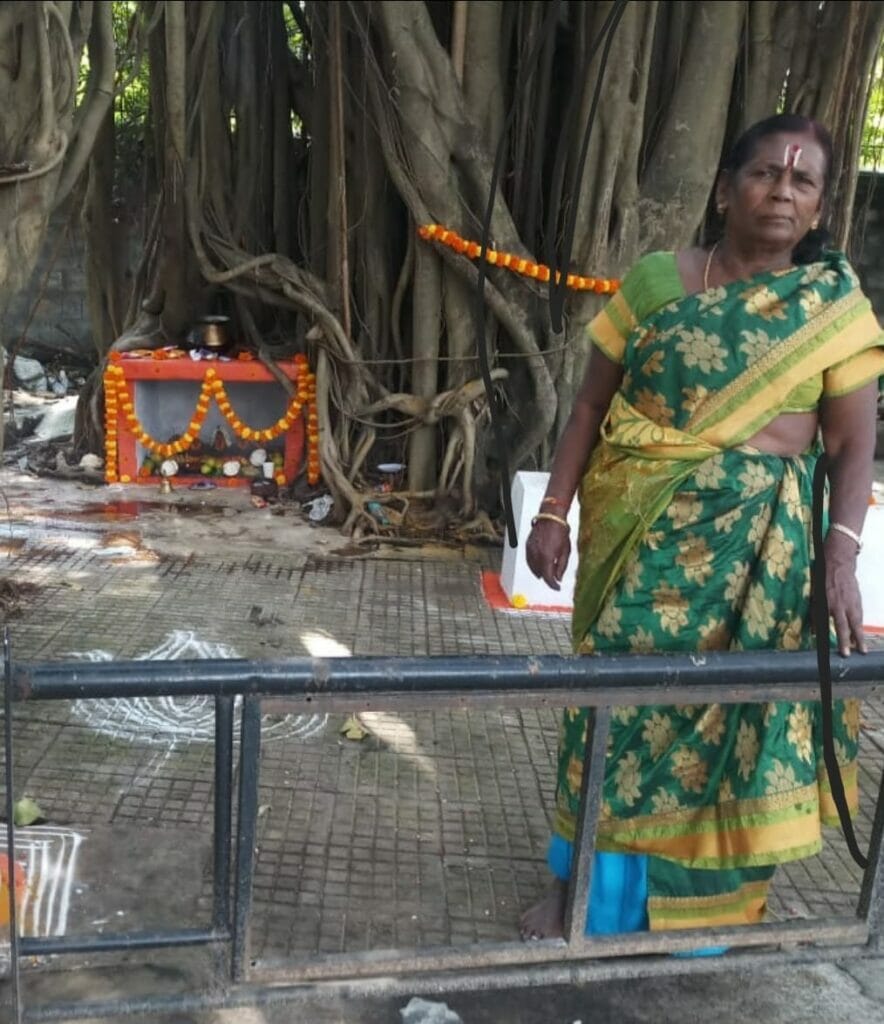‘’A man doesn’t plant a tree for himself, he plants it for future generations,” Alexander Smith
Often, getting cool shade under a tree has become a luxury in Bengaluru. Especially during summer or on a hot day, you can see people and animals standing in the shade of a building, rather than a tree. However, all is not lost. There are people who have planted and nurtured trees, contributing to the preservation of the city’s green canopy.
I came across a beautiful majestic banyan tree just in front of Lalbagh, double roadside entrance. I was admiring the sheer size of the tree and the beauty of nature that has created these aerial roots, which look like a curtain, are weaved so beautifully. While I enjoyed the cool, fresh air and shade under the tree, on a hot day, the busiest space in central Bengaluru, I decided to find out a little more about the history of this tree. This inspired me to start a whole series on such trees in the city.

Read more: It’s been a long and difficult struggle to preserve Bengaluru’s trees
As Shri Krishna says, in chapter 10, 26th verse in the Bhagavad Gita, Asvatthah sarva vrukshanam ‘’of all the trees I am the Banyan tree ‘’- This particular saying was apt while I heard the story of this Banyan tree.
Munishwara Lakshmi, a sugar cane juice vendor, established her shop in the early 1970s along the roadside in front of Lalbagh. She recollects that there were frequent accidents in that particular spot and there was no shade in the vicinity. While her business picked up, she felt the need to act and plant a tree.

Lakshmi said this banyan tree was planted in 1988, with a prayer to protect and keep everyone safe. It has been 34 years since, and the tree is as old as her daughter, she chuckles. She says this was also planted to get good shade, for nesting birds to thrive, and for all species to coexist. She still has the shop and sells her wares under the tree. She says, “Sitting under this tree gives me utmost satisfaction and it gives me so much joy when I see the number of birds taking shelter and when people enjoy the shade.”
She was amazed to see the small plant grow rapidly in a short span of time and take an aerial root structure, which captures everyone’s attention. This tree protects the passersby. She claims there have been no accidents in this area ever since this tree was planted. She regularly offers prayers, along with her family, for everyone’s well-being.
There were many incidents of threats to the survival of the tree, which Lakshmi’s family fought for.

Lakshmi requests to save these trees, which is benefitting not just humans, but all other species as well. She has planted a few more trees, like rain trees and flowering trees, in and around Lalbagh as well.
When I asked her how she managed to water them, she says she carried water pots in a small 4-wheel cart and manually watered the saplings every day. She takes pride and joy while sharing her journey nurturing the trees.
While carefully guarding these trees, families and passers-by have connected and are sure the next generation will join in to protect these trees. Behind every single tree that is still standing in Bengaluru, there is a person guarding it.

We are grateful to many such good samaritans and citizens, who have nurtured trees without any expectations and which has resulted in benefits for a larger cause. We pray this tree stands tall and is protected against all odds of rapid urbanisation and stands as a living testimony for the future generation.
Green infrastructure is pivotal for a balanced ecosystem and natural biodiversity, which should not be compromised with extensive unmindful urbanisation. Both must coexist.
Read more: Close shave for Palace Orchards: Sankey road flyover would sound a death knell for heritage trees
Native plants matter
Preserving native plant habitats is vital to preserving biodiversity. The urbanised obsession with
highly manicured perfect lawns – ‘’green monoculture carpet’’ and ornamental alien plants from other countries have led to the downfall of the whole native ecosystem habitat of Bengaluru in many residential complexes and commercial spaces.
Despite native plants’ low cost and maintenance and so many benefits, there are hardly any takers for native plants. Meaningful landscape choices will create a healthy ecosystem, which is healthy for you, your family and your community
Facts of trees
- Trees are the oldest living species on the planet
- Tree rings predict not just their age, but climate change and can help you find direction
- Trees communicate, defend against pests, improve water quality, combat climate change
- Being around trees is a great stress buster
Did you know?
Different parts of the trees grow at different times throughout the year
- Foliage growth – Spring
- Trunk growth – Summer
- Root growth – Winter
Suggestions of a few native plants
Mehendi, a wide variety of basil, lemongrass, native hibiscus, moringa, curry leaves, and turmeric do not damage any many made constructions. These humble plants will serve you better, look more beautiful and be very useful too.
Citizens should make such small changes to preserve and protect namma Bengaluru’s rich biodiversity.
This article is part of the Citizen Journalism for Changemakers-CJC Programme, which was conducted from February to March 2023. This programme was supported by Rohini Nilekani Philanthropies.